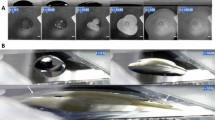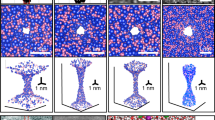Abstract
IN the course of an investigation on electro-deposition to determine the cause of what Ibl and Muller1 called an “anomalous maximum” near the cathode, and which O'Brien and Axon2 independently noted and named the “second wave” in a complete, electrode-to-electrode interference pattern, it was found that this second wave does not develop in electrolyte solutions in which ion-pairs do not form. Such a solution is nickel sulphate3, in which it has been shown that, presumably because of the strength of the bonds and lack of lability in the octahedral nickel aquo-complex, the closest approach of the sulphate ion cannot be less than the diameter of one water molecule (see Figs. 1 and 2). Electrolysis of a silver perchlorate solution gave the faintest traces of a second wave, which may be considered to be additional supporting evidence. Since Fajans and Luhdemann4 have shown that free ions in solution may be expected to give higher refractive indices than ion pairs, and indeed a plot of concentrations versus refractive index of values taken from Landolt-Bornstein shows no deviation from linearity for nickel sulphate (which deviation is usually attributed to ion-pairs) until concentrations in the neighbourhood of 1 M, it follows that the cathode maximum may be explained by the dissociation of ion-pairs.
This is a preview of subscription content, access via your institution
Access options
Subscribe to this journal
Receive 51 print issues and online access
$199.00 per year
only $3.90 per issue
Buy this article
- Purchase on Springer Link
- Instant access to full article PDF
Prices may be subject to local taxes which are calculated during checkout
Similar content being viewed by others
References
Ibl, N., and Muller, R. H., Z. Elektrochem., 59, 671 (1955).
O'Brien, R. N., and Axon, H. J., Trans. Inst. Met. Finishing, 34, 4 (1957).
Duncan, J. F., and Keppert, D. L., in “The Structure of Electrolyte Solutions”, edit. by Hamer, 398 (John Wiley and Sons, New York, 1959).
Fajans, K., and Luhdemann, R., Z. phys. Chem., B, 29, 150 (1935).
Author information
Authors and Affiliations
Rights and permissions
About this article
Cite this article
O'BRIEN, R., ROSENFIELD, C. Possible Discovery of Ion-Pairs by Interferometry. Nature 187, 935–936 (1960). https://doi.org/10.1038/187935a0
Issue Date:
DOI: https://doi.org/10.1038/187935a0
This article is cited by
-
Free Convection in Micro-electrolysis Cells
Nature (1964)
Comments
By submitting a comment you agree to abide by our Terms and Community Guidelines. If you find something abusive or that does not comply with our terms or guidelines please flag it as inappropriate.



